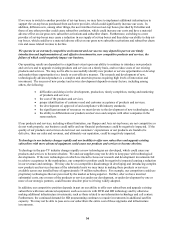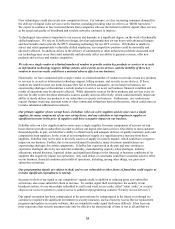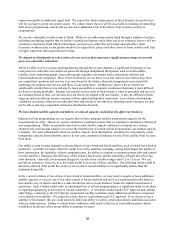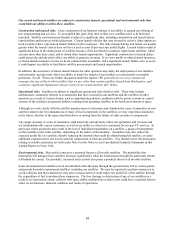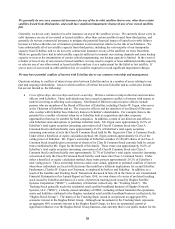Dish Network 2014 Annual Report Download - page 54
Download and view the complete annual report
Please find page 54 of the 2014 Dish Network annual report below. You can navigate through the pages in the report by either clicking on the pages listed below, or by using the keyword search tool below to find specific information within the annual report.44
44
D1 is not used in the commercialization of our wireless spectrum or for other commercial purposes, we may need to
further impair it in the future, which could materially and adversely affect our future results of operations.
To the extent that we commercialize our wireless spectrum licenses, we will face certain risks entering and
competing in the wireless services industry and operating a wireless services business.
We have made substantial investments to acquire certain wireless spectrum licenses and related assets. We may also
determine that additional wireless spectrum licenses may be required to commercialize our wireless business and to
compete with other wireless service providers. We will need to make significant additional investments or partner
with others to, among other things, commercialize, build-out, and integrate these licenses and related assets, and any
additional acquired licenses and related assets; and comply with regulations applicable to such licenses. Depending
on the nature and scope of such commercialization, build-out, integration efforts, and regulatory compliance, any
such investments or partnerships could vary significantly. We may need to raise significant additional capital in the
future to fund these efforts, which may not be available on acceptable terms or at all. There can be no assurance that
we will be able to develop and implement a business model that will realize a return on these wireless spectrum
licenses or that we will be able to profitably deploy the assets represented by these wireless spectrum licenses, which
may affect the carrying value of these assets and our future financial condition or results of operations.
To the extent we commercialize our wireless spectrum licenses and enter the wireless services industry, a wireless
services business presents certain risks. Any of the following risks, among others, may have a material adverse
effect on our future business, results of operations and financial condition.
The wireless services industry is competitive and maturing. We have limited experience in the wireless
services industry, which is a competitive and maturing industry with incumbent and established
competitors such as Verizon, AT&T, Sprint Corporation (“Sprint”) and T-Mobile USA Inc. (“T-Mobile”).
These companies have substantial market share and have more wireless spectrum assets than us. Some of
these companies have greater financial, marketing and other resources than us, and have existing cost and
operational advantages that we lack. Market saturation is expected to continue to cause the wireless
services industry’s customer growth rate to moderate in comparison to historical growth rates, leading to
increased competition for customers. As the industry matures, competitors increasingly must seek to attract
a greater proportion of new subscribers from each other’s existing subscriber bases rather than from first-
time purchasers of wireless services. Furthermore, the cost of attracting a new customer is generally higher
than the cost associated with retaining an existing customer. In addition, we may face increasing
competition from wireless telecommunications providers who offer mobile video offerings. Wireless
mobile video offerings will likely become more prevalent in the marketplace as wireless
telecommunications providers implement and expand the fourth generation of wireless communications.
During May 2014, AT&T announced its pending acquisition of DirecTV, which is currently undergoing
regulatory review and has not been completed. We filed a petition to impose conditions on the transaction
with the FCC, to remedy potential threats to consumers and competition in the video and broadband
markets. If DirecTV ultimately is acquired by AT&T, DirecTV will, among other things, have increased
access to capital, access to AT&T’s nationwide platform for wireless mobile video, and the ability to more
seamlessly bundle its video services with AT&T’s broadband Internet access and voice services. The
combined company would also be able to, among other things, pressure third-party content owners and
programmers to withhold online rights from us; utilize its increased leverage over third-party content
owners and programmers to reduce the price it pays for programming at the expense of other MVPDs,
including us; thwart our entry into the wireless market, by, among other things, refusing to enter into data
roaming agreements with us; foreclose or degrade our online video offerings at various points in the
broadband pipe; and impose anti-competitive data caps on consumers who access our online video
offerings.
Our ability to compete effectively would be dependent on a number of factors. Our ability to compete
effectively would depend on, among other things, our network quality, capacity and coverage; the pricing
of our products and services; the quality of customer service; our development of new and enhanced
products and services; the reach and quality of our sales and distribution channels; and capital resources. It
would also depend on how successfully we anticipate and respond to various competitive factors affecting
the industry, including, among others, new technologies and business models, products and services that


